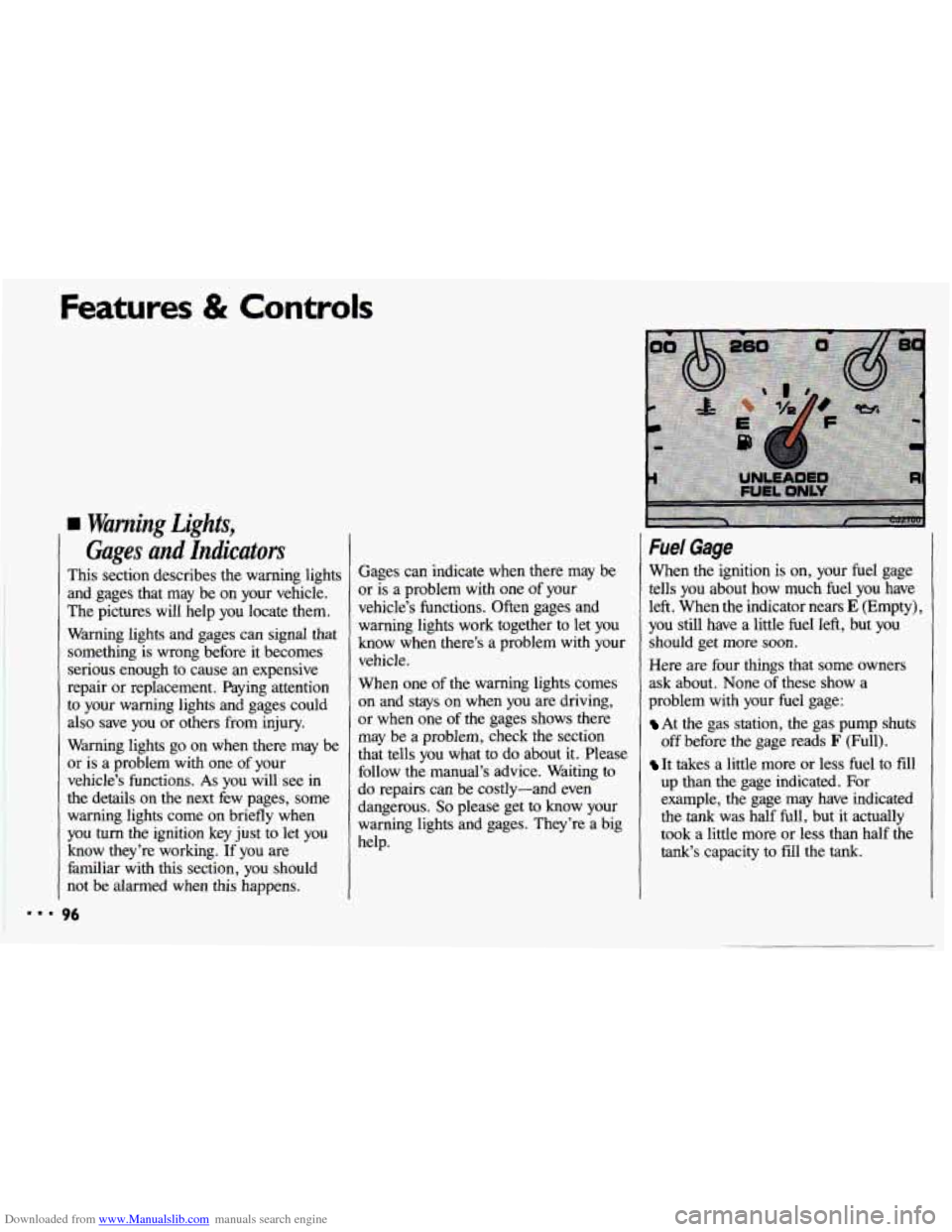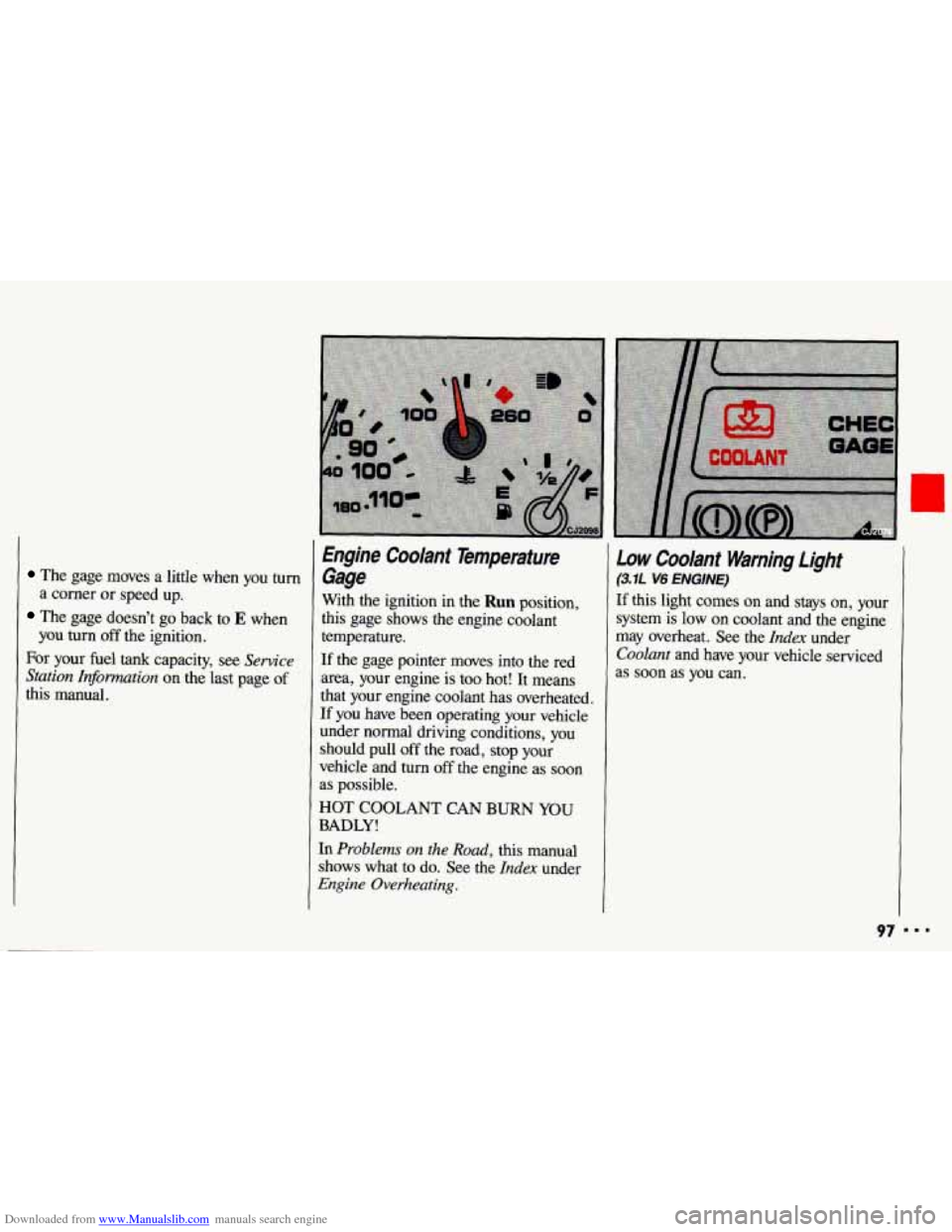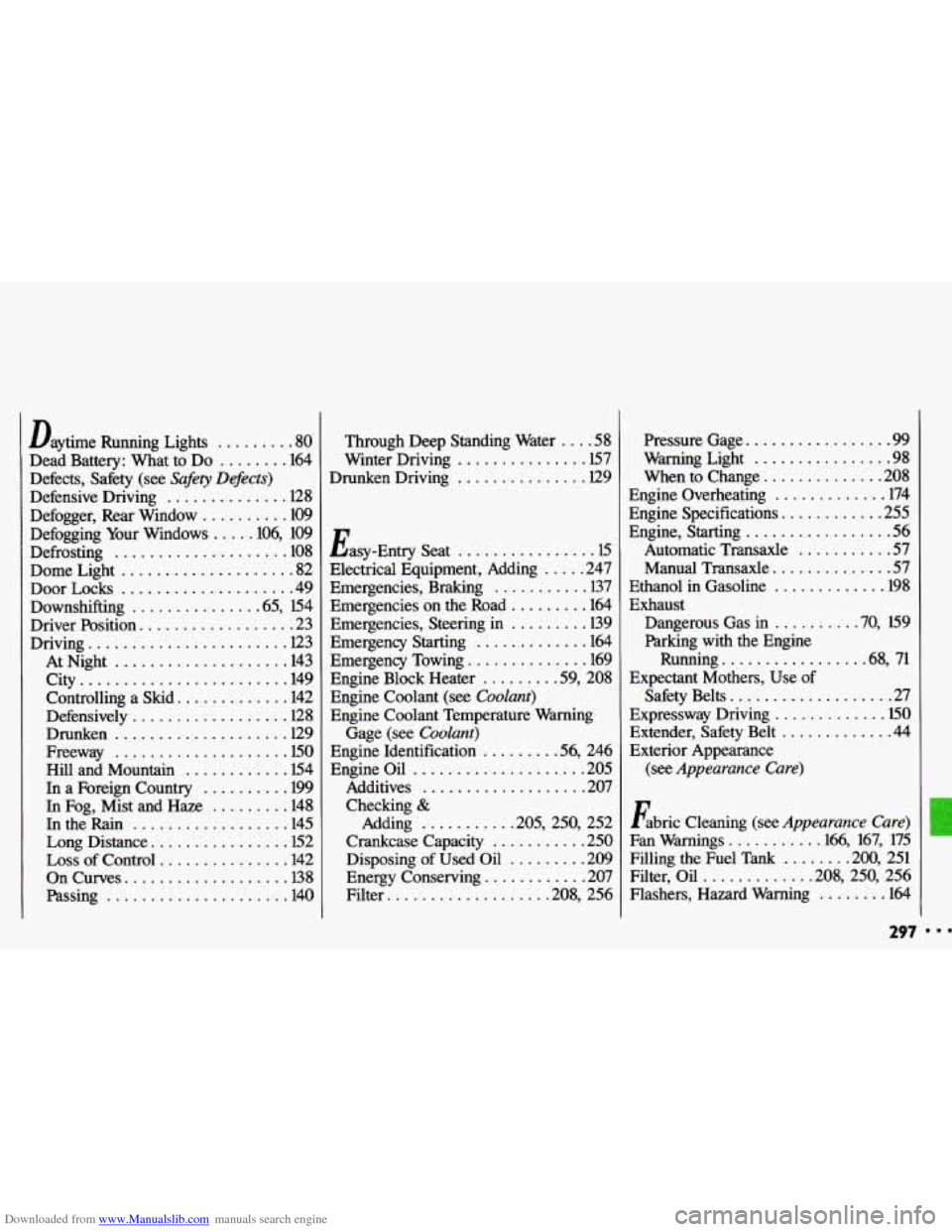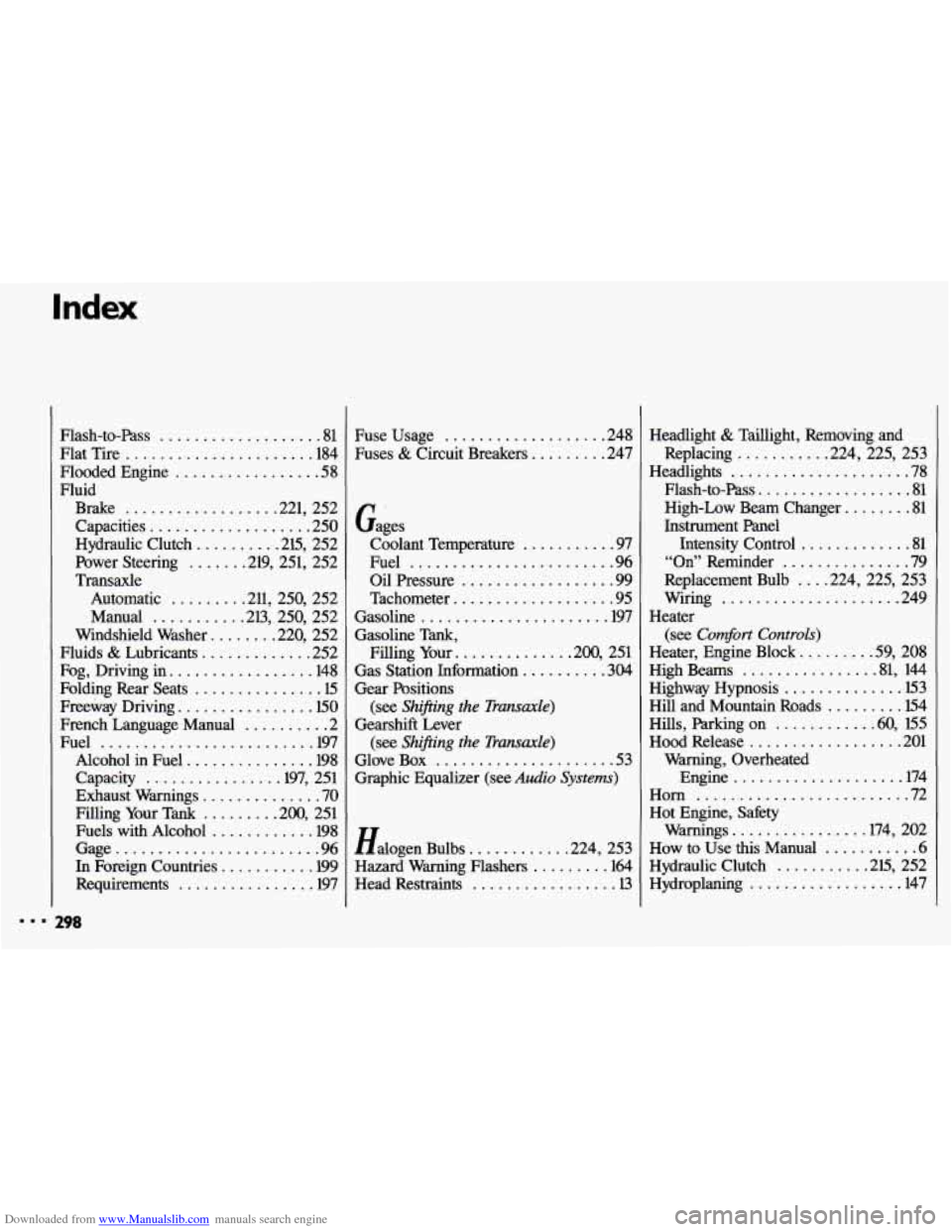1993 CHEVROLET CAVALIER fuel tank capacity
[x] Cancel search: fuel tank capacityPage 98 of 308

Downloaded from www.Manualslib.com manuals search engine Features & Controls
Warning Lights,
Gages and Indicators
This section describes the warning lights
and gages that may be on your vehicle.
The pictures will help
you locate them.
Warning lights and gages can signal that something is wrong before it becomes
serious enough
to cause an expensive
repair or replacement. Paying attention
to your warning lights and gages could also save you or others from injury.
Warning lights
go on when there may be
or is a problem
with one of your
vehicle’s functions.
As you will see in
the details on the next few pages, some
warning lights come on briefly when
you turn the ignition key just to let you
know they’re working. If you are
familiar with this section, you should
not be alarmed when this happens. Gages can indicate when there
may be
or is a problem with one
of your
vehicle’s functions. Often gages
and
warning lights work together to let you
know when there’s a problem with your
vehicle.
When one of the warning lights comes
on and stays on when you are driving,
or when one
of the gages shows there
may be a problem, check the section
that tells you what to do about it. Please
follow the manual’s advice. Waiting to
do repairs can be costly-and even
dangerous.
So please get to know your
warning lights and gages. They’re a big
help.
Fuel Gage
When the ignition is on, your fuel gage
tells
you about how much fuel you have
left. When the indicator nears
E (Empty),
you still have a little fuel left, but you
should get more soon.
Here are four things that some owners
ask about. None
of these show a
problem with your fuel gage:
At the gas station, the gas pump shuts
off before the gage reads
F (Full).
It takes a little more or less fuel to fdl
up than the gage indicated. For
example, the gage may have indicated
the
tank was half full, but it actually
took a little more or less than half the
tank‘s capacity to fill the tank.
Page 99 of 308

Downloaded from www.Manualslib.com manuals search engine The gage moves a little when you turn
The gage doesn’t go back to E when
For your fuel
tank capacity, see Service
Station Information
on the last page of
this manual. a
comer or speed up.
you
turn off the ignition.
Engine Coolant Temperature
Gage
With the ignition in the Run position,
this gage shows
the engine coolant
temperature.
If the gage pointer moves into the red
area, your engine is
too hot! It means
that your engine coolant has overheated.
If you have been operating your vehicle
under normal driving conditions, you
should pull
off the road, stop your
vehicle and turn
off the engine as soon
as possible.
HOT COOLANT CAN BURN YOU
BADLY!
In Problems on the Road, this manual
shows what to do. See the
Index under
Engine Overheating.
Law Coolant Warning Light
(3.7L V6 ENGiNE)
If this light comes on and stays on, your
system is low on coolant and the engine
may overheat. See the
Index under
Coolant and have your vehicle serviced
as soon as
you can.
97
Page 299 of 308

Downloaded from www.Manualslib.com manuals search engine Daytime Running Lights ........ -80
Dead Battery: What to Do ........ 164
Defects. Safety (see
Safety Defects)
Defensive Driving .............. 128
Defogger. Rear Window .......... 109
Defrosting
.................... 108
Dome Light
.................... 82
Door Locks
.................... 49
Downshifting
.............. .65. W4
Driver Position
.................. 23
Driving
....................... 123
At Night
.................... 143
City
........................ 149
Controlling a Skid
............. 142
Defensively
................. -128
Drunken .................... 129
Freeway
.................... 150
Hill and Mountain ............ 154
In a Foreign Country
.......... 199
In Fog, Mist and Haze ......... 148
In the Rain .................. 145
Long Distance
................ 152
Loss
of Control ............... 142
On Curves
................... 138
Passing
..................... 140
Defogging
Your Windows
.... .106. 109 Through
Deep Standing Water
.... 58
Winter Driving ............... 157
Drunken Driving
............... 129
n
Easy-Entry Seat ................ 15
Electrical Equipment. Adding ..... 247
Emergencies. Braking
........... 137
Emergencies on the Road
......... 164
Emergencies. Steering in
......... 139
Emergency
Starting ............. 164
Emergency Towing
.............. 169
Engine Block Heater
........ .59, 208
Engine Coolant (see
Coolant)
Engine Coolant Temperature Warning
Engine Identification
........ .56. 246
Engine Oil
.................... 205
Additives
................... 207
Checking
&
Adding .......... .205. 250. 252
Crankcase Capacity
........... 250
Disposing of Used Oil ......... 209
Energy Conserving
............ 207
Filter
.................. .208. 256
Gage
(see Coolant)
Pressure Gage ................. 99
Warning Light ................ 98
When to
Change .............. 208
Engine Overheating
............. 174
Engine Specifications
............ 255
Engine, Starting
................. 56
Automatic Transaxle ........... 57
Manual Transaxle
.............. 57
Ethanol in Gasoline ............. 198
Exhaust Dangerous
Gas in ......... .70, 159
Parking with the Engine Running
................ .68, 71
Expectant Mothers, Use of
Safety Belts
................... 27
Expressway Driving
............. 150
Extender. Safety Belt ............ -44
Exterior Appearance
(see
Appearance Care)
Fabric Cleaning (see Appearance Care)
Fan Warnings .......... .166. 167. 175
Filling
the Fuel Tank ....... .200. 251
Filter. Oil
............ .208, 250. 256
Flashers, Hazard Warning
........ 164
297 r
Page 300 of 308

Downloaded from www.Manualslib.com manuals search engine Flash-to-Pass ................... 81
Flat Tire
...................... 184
Flooded Engine
................. 58
Fluid Brake
................. .221. 252
Capacities
................... 250
Hydraulic Clutch
......... .2l5. 252
Power Steering
...... .219. 251. 252
Transaxle
Automatic
........ .211. 250. 252
Manual
.......... .2l3. 250. 252
Windshield Washer
....... .220. 252
Fluids
& Lubricants ............. 252
Fog. Driving in
................. 148
Folding Rear Seats
............... l5
Freeway Driving ................ 150
French Language Manual .......... 2
Fuel
......................... 197
Alcohol in Fuel
............... 198
Capacity
............... .197. 251
Exhaust Warnings
.............. 70
Filling Your Tank
........ .200. 251
Fuels with Alcohol
............ 198
Gage
........................ 96
In Foreign Countries ........... 199
Requirements
................ 197
198
Fuse Usage ................... 248
Fuses
& Circuit Breakers ......... 247
Gaies Coolant Temperature
........... 97
Fuel
........................ 96
Oil Pressure
.................. 99
Tachometer
................... 95
Gasoline
...................... 197
Gasoline Tank. -Filling Your
............. .200. 251
Gas Station Information
.......... 304
Gear Positions
Gearshift Lever
Glove Box
.................... i., . 53
Graphic Equalizer (see
Audio Systems)
(see Shlfing the Transaxle)
(see Shifting the Transaxle)
Halogen Bulbs ........... .224. 253
Hazard Warning Flashers
........ -164
Head Restraints
................. 13
Headlight & Taillight. Removing and
Replacing
.......... .224. 225. 253
Headlights
..................... 78
Flash-to-Pass
.................. 81
High-Low Beam Changer
........ 81
Instrument Panel Intensity Control
............. 81
“On” Reminder
............... 79
Replacement Bulb
... .224. 225. 253
Wiring
..................... 249
(see
Comfort Controls)
Heater Heater. Engine Block
........ .59. 208
High Beams
............... .81. 144
Highway Hypnosis
.............. 153
Hill and Mountain Roads
......... 154
Hills. Parking on
........... .a. 155
Hood Release .................. 201
Engine
.................... 174
Horn
......................... 72
Hot Engine. Safety
Warnings
............... .174. 202
How to Use
this Manual ........... 6
Hydraulic Clutch .......... .2l5. 252
Hydroplaning
.................. 147
Warning. Overheated